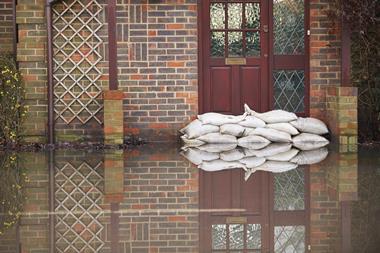Insurance Times speaks exclusively to Flood Re at the launch of its latest Transition Plan
Flooding is an unruly force of nature that causes deaths and can leave mass destruction in its wake, while leaving behind what can be years of consequential damage to wellbeing, livelihoods and homes.

For residents of North Korea, the US and northern India, flooding is an experience that many are currently hoping to survive.
And although recent flooding events in the UK have been no less severe in comparison, the “power of flooding” shown through the experience of neighbours overseas means the UK “should not be complacent” that flooding levels here have been “quite banal”, especially as threats from extreme weather increase.
That was according to Flood Re chief executive Andy Bord, who spoke at the launch of the firm’s 2023 Transition Plan at the Gherkin in central London last week (13 July 2023).
The Transition Plan examined flood risk over the next 20 years and set out what Bord describes as a “clear direction of travel” that the UK needs to take to make sure it is flood resilient by the time Flood Re exits the market in 2039 – a deadline that Bord confirmed “will happen”.
The document is Flood Re’s third iteration of the plan, following the release of its first and second in February 2016 and July 2018 respectively.
Speaking exclusively to Insurance Times, Bord said: “It would be a collective failure on behalf of us all – the industry, government and Flood Re – if we’re in a position when we come to exit the market and those homes don’t have access to affordable home insurance, which will only be possible if the appropriate defences get built, homes get built in the right places and the appropriate adaptations are made.”
“If significant numbers of homes are left unprotected when we leave the market in 2039,” added Flood Re exiting chair Mark Hoban, “both the insurance and £1.3tn mortgage sectors could find themselves facing instability.”
Housing
According to research from Axa, between 70,000 and 120,000 homes were built in flood-prone areas in England from 2009 and 2020.
Read: Flood Re’s new campaign to help increase uptake of property flood resilience measures
Read: Property claims for flood damage significantly drop
Explore more sustainability content here or discover other news stories here
Personal lines insurer LV= then reported in November 2021 that an additional 200 planning permissions had been granted for 5,283 new homes to be built in the highest-risk local authorities in the country, with a total of 4,255 located in areas pre-identified as highly likely to flood.
Considering the current high demand for housing and lack of properties available, Bord highlighted that “it is possible to build homes on floodplains”.
However, properties must be “built in the right way, [and] to the right standard” – one challenge regarding this, however, is that “the right enforcement to make sure that has happened” is “currently missing”.
Drawing on his experience attending a roundtable discussion in Parliament this month (June 2023), which focused on “how planning reforms can help”, Aviva chief executive of UK and Ireland general insurance Adam Winslow shared that “too many homes are still being built in the highest risk areas with no flood defences, which feels like we’re kicking the can down the road”.
To improve the current housing versus flooding situation, Flood Re has committed to several first steps as part of its most recently released plan.

Firstly, Bord stated Flood Re was going to “recommit to Build Back Better”, which he hoped would become a “standard part of home insurance” within the next year.
Build Back Better, launched by Flood Re in April 2022, allows participating insurers to offer customers a reimbursement of up to £10,000 for property flood resilience (PFR) measures on top of the cost of repair work caused by flood damage.
Bayes Business School Research Centre’s research report – The impact of flood risk on England’s property market, published 16 May 2023 – highlighted, however, that “semi-detached and terraced houses are more vulnerable to flooding since any temporary protection measures, such as blocking doors, windows, vents and pipes, will not be effective unless their neighbours take similar steps”.
Price reflection
To drive a “deeper understanding” among the insurance market of Build Back Better, Flood Re published a training video in April 2023. At that point, Flood Re stated that 65% of insurers had signed up to support the scheme.
At the event last week, Bord shared that “three-quarters” (75%) of the industry had now committed.
Flood Re will also support research and work with partners to create a scoring methodology for property flood resilience (PFR) adaptions as part of its Transition Plan, with the aim of better enabling the insurance market to assess how these mitigate the risk and damage of flooding. Premiums will then be able to reflect improved resilience.
“It’s fair to say that the PFR industry has absolutely been innovating and has been growing, but it’s been growing at a linear level,” said Bord.
“We need that growth to be absolutely exponential if we’re going to cope with [climate change] challenges and that scoring methodology will start to unlock new funding streams both [in the] private and public sector.”
To ensure the flood prevention and resilience “knowledge infrastructure” is “available for everybody”, Flood Re will launch a Centre of Excellence, which Bord hopes will be comparable to Thatcham Research’s impact on the motor insurance industry.
Hoban said: “We’ve been largely fortunate in recent years and escaped the widespread flooding that will inevitably return and become more persistent in the UK as the climate gets wetter and warmer.
“While we can be proud of what has been achieved, we need to go much further as climate change-related damages grow.
“This is not just about a small number of homes by a river or on the coast – over three million homes in urban areas are now at risk of flash flooding.”
Hosted by comedian and actor Tom Allen, 34 Gold, 23 Silver and 22 Bronze awards were handed out across an amazing 34 categories recognising brilliance and innovation right across the breadth of UK general insurance.




















































No comments yet